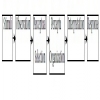Home | ARTS | Management Concepts & Organisational Behaviour
|
Making Better Use of Informal Organisation
Management Concepts & Organisational Behaviour - Formal And Informal Organization
Making Better Use of Informal Organisation
Posted On :
The management should not look down upon the informal organization as it arises spontaneously along with the formal organization and fills in some of the vital gaps in the formal organization.
Making
Better Use of Informal Organisation
The management should not look down upon the informal organization as it arises spontaneously along with the formal organization and fills in some of the vital gaps in the formal organization. It may be noted that formal organization is unable to meet all the needs (e.g. affiliation, affection, esteem, etc.) of its members. Management can fulfill these needs of the workers by encouraging informal organization as it provides a buffer to absorb the shocks of tensions and frustrations among the members as a result of formal organizational pinpricks.
Informal organization may act to fill in gaps in a manager’s abilities. For instance, if a manager is weak in planning, one of his subordinates may informally help him in such a situation. Management may also make use of informal group leaders by taking them into confidence to mediate as bridges of understanding between the management and the employees. Startle has rightly said, “Informal structure is one index of the dynamics of getting work done and it appears that, for efficiency, it will necessarily deviate from the formal structure”. Therefore, management should adopt a positive attitude towards informal organization. It should use it along with formal structure to make workable system for achieving the organizational objectives.
The management should not look down upon the informal organization as it arises spontaneously along with the formal organization and fills in some of the vital gaps in the formal organization. It may be noted that formal organization is unable to meet all the needs (e.g. affiliation, affection, esteem, etc.) of its members. Management can fulfill these needs of the workers by encouraging informal organization as it provides a buffer to absorb the shocks of tensions and frustrations among the members as a result of formal organizational pinpricks.
Informal organization may act to fill in gaps in a manager’s abilities. For instance, if a manager is weak in planning, one of his subordinates may informally help him in such a situation. Management may also make use of informal group leaders by taking them into confidence to mediate as bridges of understanding between the management and the employees. Startle has rightly said, “Informal structure is one index of the dynamics of getting work done and it appears that, for efficiency, it will necessarily deviate from the formal structure”. Therefore, management should adopt a positive attitude towards informal organization. It should use it along with formal structure to make workable system for achieving the organizational objectives.
Most informal groups tend to be
small. Each has its leader, who was not elected or appointed, but earned the
status because of age, seniority on the job, dominant personality, special
capability, physical strength or some other characteristic. However, in large
informal organizations, there may be more than one leader whom the group will
follow under given circumstance. An individual with more formal education than
the others may be looked to in matters that require formal communication. He
may be asked to speak for the group in dealings with management, the union, or
other informal groups. Another members possessing more job experience and “know-how”
may be consulted when direction or guidance is needed in handling a work
assignment or solving some problems connected with it. A manager should
identify informal leaders and work with them.
A manager can build favorable relations with informal leaders in several ways. He can consult the leaders and seek their advice on technical matters or human relations problems. He can request their assistance and cooperation in inducting new members and training them to become competent workers in their formal job assignments. Open, two-way communication can be encouraged on a continuing basis for mutual benefit. A manager must be careful not to reduce the status of the leader in the eyes of his constituents. Informal communication system though may have certain ill consequences, can also be used by an enlightened manager to plug the loopholes of the formal communication system. Informal communications is very fast and ensures speedy transmission of information. It is the duty of every manager to see that informal communication does not produce rumors and if a rumor spreads, it should not be allowed to damage the functioning of the organization. In short, management can use every aspect of informal organization to achieve the organization objectives.
A manager can build favorable relations with informal leaders in several ways. He can consult the leaders and seek their advice on technical matters or human relations problems. He can request their assistance and cooperation in inducting new members and training them to become competent workers in their formal job assignments. Open, two-way communication can be encouraged on a continuing basis for mutual benefit. A manager must be careful not to reduce the status of the leader in the eyes of his constituents. Informal communication system though may have certain ill consequences, can also be used by an enlightened manager to plug the loopholes of the formal communication system. Informal communications is very fast and ensures speedy transmission of information. It is the duty of every manager to see that informal communication does not produce rumors and if a rumor spreads, it should not be allowed to damage the functioning of the organization. In short, management can use every aspect of informal organization to achieve the organization objectives.
Tags : Management Concepts & Organisational Behaviour - Formal And Informal Organization
Last 30 days 374 views













